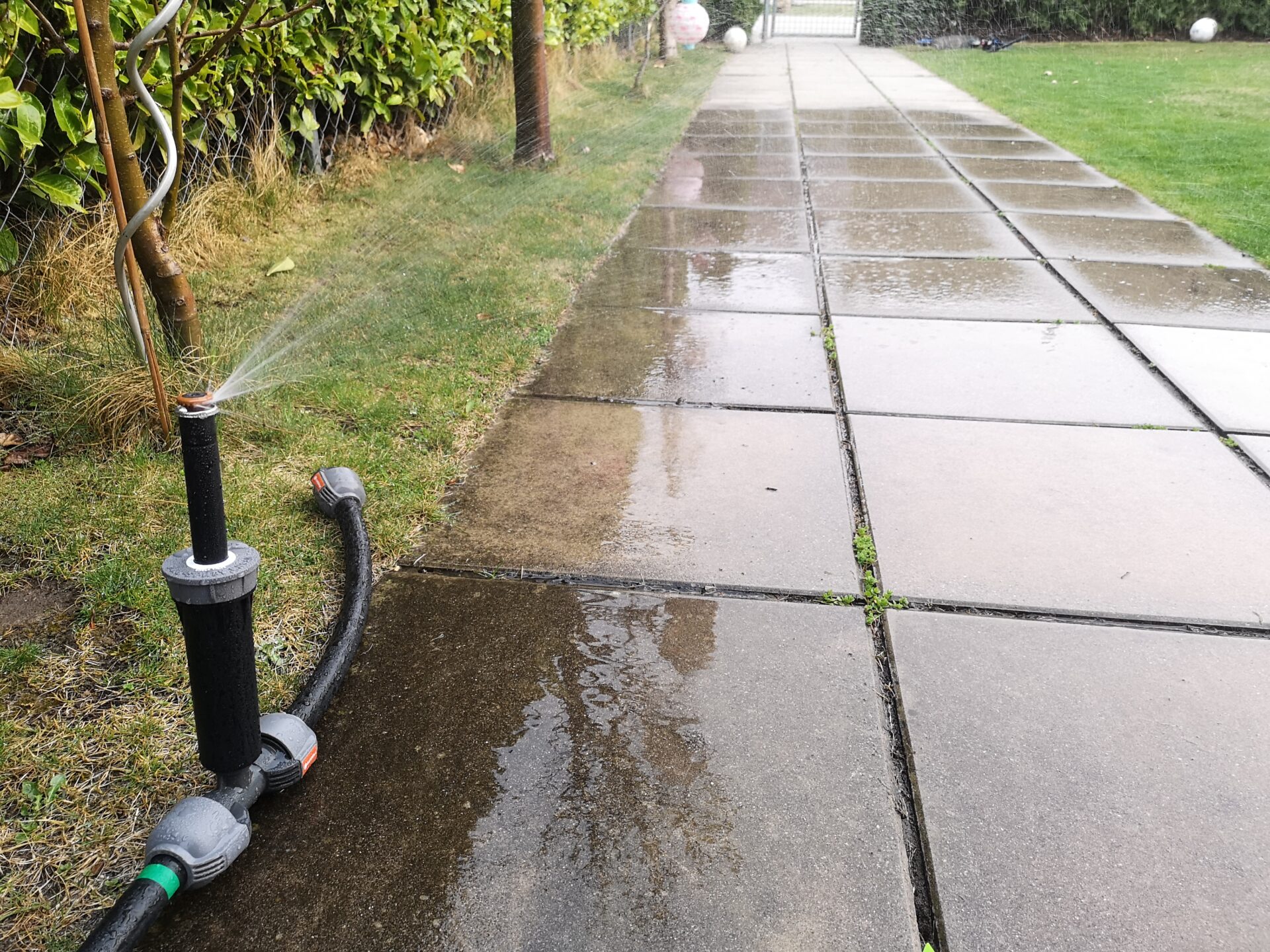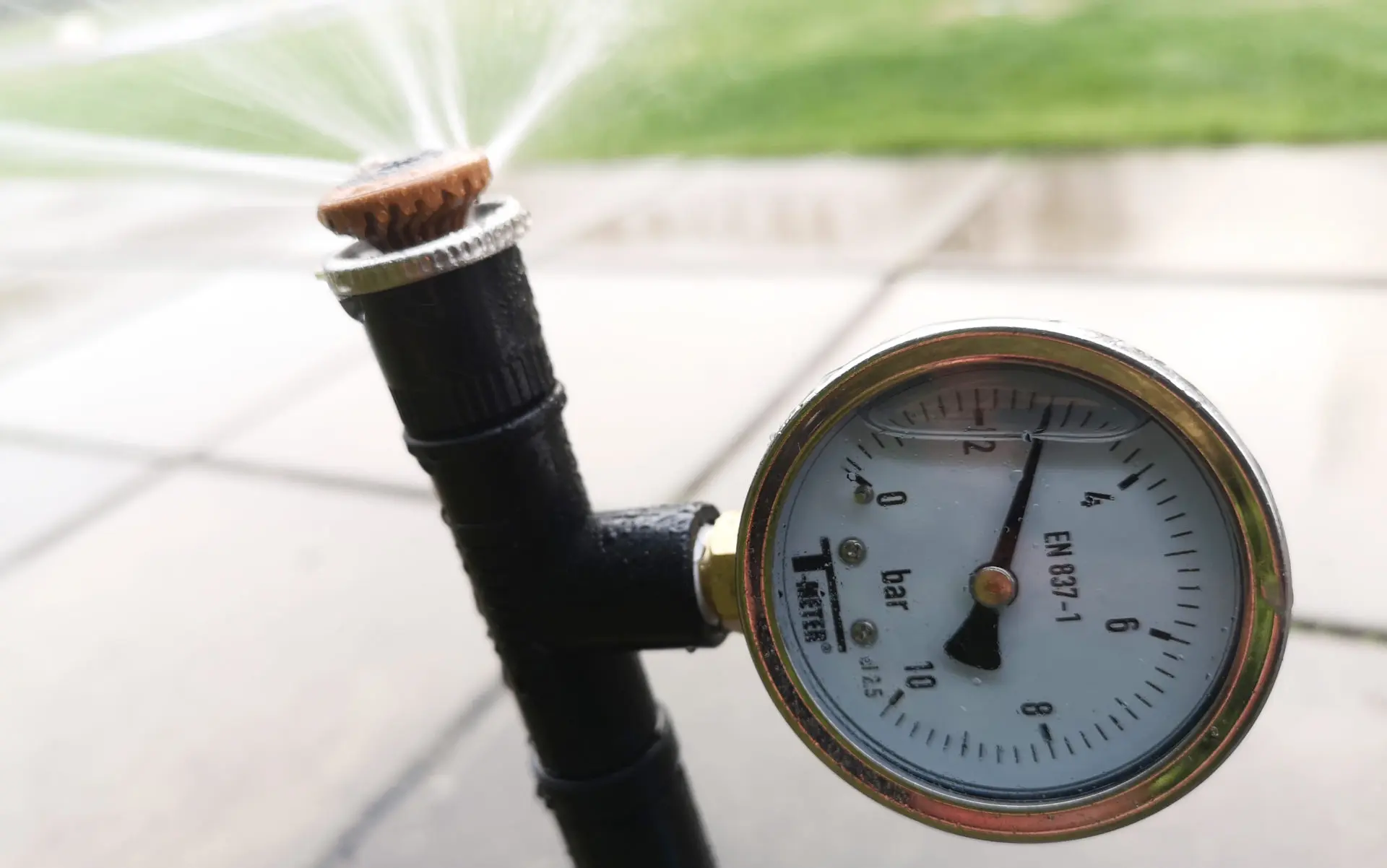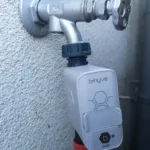Irrigating a narrow, elongated area is one of the most difficult tasks when installing irrigation. Some manufacturers offer strip sprinklers specially developed for this purpose. This article uses the Hunter MP-Rotator side strip sprinklers to show how such strip sprinklers work and how well they perform in practice, and highlights other alternatives from other suppliers.
The solution approach of strip sprinklers sounds compelling: instead of supplying a narrow strip of lawn with water using a large number of small circular sprinklers or sprayers, sprinklers are used that irrigate an almost rectangular pattern. This is why they are often referred to as rectangular sprinklers.
Such sprinklers are offered by Hunter, Rain Bird and other suppliers, although only Hunter with the MP-Rotator strip sprinklers and Rain Bird with the R-VAN strip sprinklers offer a rotating sprinkler type (rotating nozzle sprinkler), most of the other solutions offered are nozzle sprinklers that release the water in a comparatively gush-like manner and in large quantities. You notice this difference when comparing the rainfall rates.
The rectangular irrigation pattern is not achieved with one sprinkler alone in all solutions, but rather several sprinklers must be placed in a coordinated manner. With one sprinkler alone, many places, especially in the immediate vicinity of the sprinkler, would remain completely dry and even irrigation would not be possible.
Introducing the Hunter MP-Rotator side strip sprinkler
With this solution, three sprinklers are placed in a predetermined pattern to supply a strip of lawn. The width of the lawn strip is 60 inches. The Hunter MP Rotator side strip sprinkler is a circular sprinkler from the MP-Rotator family that has very low water consumption and also works according to the MPR principle, i.e. ensures that the lawn is watered as evenly as possible. The water is not released in a gush, but the sprinkler head moves during irrigation and divides the water into fine strips of water.
To supply a strip of lawn measuring 60 inches x 360 inches, you need the following 3 sprinklers:
- MP-LCS 515 -> Left Corner
- MP-RCS 515 -> Right Corner
- MP-SS 530-> Side Strip, to be placed in the middle of the strip
The body for this type of sprinkler must be purchased separately. You can get a cheap Pro-Spray body for around 3 USD, or even better, you can get a PRS-40 housing that is pressure-regulated to 40 psi for 10 to 12 USD. This automatically ensures that 40 psi of pressure (and no more) reaches the sprinkler, giving it exactly the ideal pressure recommended by the manufacturer. Of course, you have to make sure that enough pressure reaches the body yourself; the body can only reduce the pressure, not increase it.
In practice, the positioning of the 3 sprinklers looks something like this:

Irrigating a rectangular strip measuring 60 x 360 inches with Hunter MP-Rotator side strip sprinklers
The three sprinklers are all placed on the same side at the edge of the strip, the LCS on the left, the SS in the middle and the RCS on the right. From the sketched throwing area, you can see that you have to rain a little beyond the strip if you want to irrigate all the edge areas of the strip as well as possible. The sprinklers would be positioned about 180 inches apart and would supply water to a strip of about 60 x 360 inches.
If you instead have a lawn strip twice as wide, about 60 x 720 inches, you would need not 6 but only 5 sprinklers, three SS and one LCS and RCS each. The sprinklers are then placed, as before, at a distance of approximately 180 inches, as follows:

Watering a rectangular strip of 60 x 720 inches with Hunter MP-Rotator side strip sprinklers
Alternatively, you can also place two of the sprinklers on the opposite side:

Alternative positioning with two opposite sprinklers
And if you want to irrigate a short strip of 60 x 180 inches, then one LCS and one RCS sprinkler are sufficient:

Positioning for a strip of 60 x 180 inches
Water pressure
Hunter recommends a pressure of 40 psi on the sprinkler to operate this type of sprinkler ideally and specifies a rectangular area of 60 x 360 feet that is irrigated at 40 psi. The easiest way to achieve this perfect 40 psi is to use the appropriate body that is regulated to 40 psi pressure (Hunter Pro-Spray PRS-40). If a slightly smaller or larger strip is to be irrigated, the throw distance can be reduced or increased by increasing or decreasing the water pressure, or the throw distance can be reduced by up to 25% by adjusting the interference screw in the sprinkler.
Since the Hunter MP-Rotator side strip, like all MP-Rotator sprinklers, has a built-in MPR principle, the precipitation rate adjusts automatically. If an alternative PRS-30 body is used, which regulates the pressure to 30 psi, the irrigated rectangle would be approximately 47 x 340 feet. As always, it should be noted that these are laboratory values that experience has shown are not quite achieved in practice. It is a good idea to always calculate about 10% less, i.e. place the sprinklers a little closer together.
Precipitation rate
The MP-Rotator side strip has a precipitation rate of approximately 0.58 inches/hour. This differs only slightly from the approximately 0.43 inches that the MP-Rotator usually has in the square pattern, so the MP-Rotator side strip sprinklers can also be operated together with the other MP-Rotator sprinklers in a zone.
This does not apply to the MP-Rotator MP800 series, as this has a precipitation rate that is almost twice as high at approximately 0.78 inches/hour. If you want to operate side strip sprinklers in a shared zone with MP800 sprinklers, Hunter recommends setting the sprinklers twice, i.e. once as described in the first and second positioning examples above and a second time opposite each other. This would result in a rainfall rate of approximately 1.14 inches per hour. Alternatively, you can also operate the side strip sprinklers in their own, independent sector.
Hunter MP-Rotator strip sprinkler in the test
I tried out the Hunter strip sprinklers in my test environment.

Hunter MP-Rotator RCS in action
The picture shows the sprinkler (RCS) to be placed in the right corner. The wet floor panels clearly show that the throw distance of 180 inches promised by the manufacturer is achieved quite well; one panel is 20 inches long and wide.

And here for comparison the MP-SS to be placed in the middle
To what extent are the throw distance and width accurate?
The test result matched the performance data promised by the manufacturer pretty well:
- The throw distance of 180 inches is pretty much achieved, only the last 20 inches were a bit tight, as only a few drops of water reached the area. In real operation, I would therefore be better off calculating with 20 inches less, so that the MPR principle is still adhered to at the last corner and it receives enough water.
- The throw width of 60 inches is covered pretty precisely. And above all: According to my test, there is hardly any overspray, and if so, only by a few inches. The MP-Rotator works very consistently and evenly. With a little fine-tuning by adjusting the sprinkler, you can water a predefined strip very precisely and reliably.
Alternatively, I also tried how the spray pattern behaves with only 30 psi pressure on the sprinkler. Result: The sprinkler works perfectly and evenly even at 30 psi. The throw distance and width are imperceptibly shorter by about 8 to 12 inches, which corresponds very well to the manufacturer’s specifications. Out of interest, I then tried going down to 20 psi and further. Even at 20 psi, the sprinkler still worked quite well, but below that the desired spray pattern was very difficult to maintain.

The pressure measurement directly on the sprinkler was carried out with an MP-Rotator measuring device, which is screwed directly in front of the nozzle.
Water Flow and Precipitation Rate
The water flow I measured of 13 gallons per hour for the RCS and LCS and 26 gallons per hour for the SS is exactly what Hunter specifies. This also matches the precipitation rate I calculated above of 0.58 inches per hour.
Other alternatives for watering a lawn strip
In addition to the strip sprinkler presented above, there are a few other ways to water a lawn strip:
Rotating strip nozzles from Rain Bird
The Rain Bird counterpart to the Hunter MP Rotator strip nozzles are the Rain Bird R-VAN strip nozzles. In terms of spray pattern and application, they are practically identical to those from Hunter.
Watering with MP800 sprinklers with a very short throw
The Hunter MP Rotator MP800 sprinkler is a “normal” circular sprinkler, but can be set to a very short throw of up to 70 inches, so that you can also water lawn strips of at least 70 inches wide. For a strip of 70 x 360 inches, this could look like this (drawn with the DVS Irrigation Irrigation Planner):

The MP800 has a precipitation rate of 0.8 inches/hour, which is about twice as high as the other MP Rotator sprinklers. You should therefore not mix them in a common zone.
Irrigation with a square sprinkler
The principle of this type of sprinkler is familiar from sprinklers that can be placed freely on the lawn: These throw the water high up and slowly swing from left to right and then back again. In this way, the area directly around the sprinkler is also supplied with water quite well. This type of sprinkler is usually not submersible; the only pop-up sprinkler I know of is the OS-140 from Gardena. Since it is possible to set the sprinkler’s throw width very narrowly, up to 40 inches wide, by variably adjusting the nozzles and the throw distance can also be greatly reduced, this sprinkler also represents an alternative for watering a narrow strip of garden. The biggest disadvantage is that the sprinkler is significantly larger than others and therefore requires a significantly larger recess in the ground than others. This is not very attractive visually and could be perceived as disturbing in the lawn.
Spray nozzles from Hunter and Rain Bird
Hunter and Rain Bird also offer classic spray nozzles with a large flow rate and a rectangular spray pattern. At Hunter, these nozzles are called the same as the MP-Rotator nozzles: RCS-515, LCS-515 and SS-530. Like the MP-Rotator side strip nozzles, these are placed on the edge of the strip. Alternatively, Hunter also offers nozzles that are placed in the middle of the strip with the CS-530 and ES-515 nozzles.
The counterpart from Rain Bird is the 15-strip series. Nozzles: 15RCS, 15LCS, 15SST (placed on the edge), 15EST, 15CST (placed in the middle of the strip).









